Game Play
The UVa Bay Game is a complex system, meaning that it is characterized by many moving, interrelated parts that can produce unexpected results. However, as a crop farmer, you can potentially have a large impact on how the Bay health fluctuates throughout the game session.
The screen shots below are intended to help you get a feel for what kinds of choices the crop farmer role requires you to make.
Making Choices
At the beginning of the game, you will be asked to set "life balance goals" in three categories:
- Economy: Is income your primary concern? Can you figure out how to stay financially stable without sacrificing the other two portions of the life balance?
- Environment: How important is the environment to you? Are you willing to make less money in order to ease your impact on the Bay?
- Quality of Life: How are you doing economically in relation to those around you? Is there a sense of "community" based on well-being of your local watershed in terms of unemployment rates, disparity of income, and life balances? This part of the life balance is complex and more difficult to gauge explicitly than the environment and economic portions.
The initial life balance goals are only set once, at the game start. The rest of the game, you can rate your contentment with your life scores on a scale of 1-10, as shown below. To the right, the blue box shows what will be visible after each advancement of the game; it compares how close your life goals are to your actual attained life balance scores.
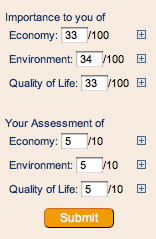
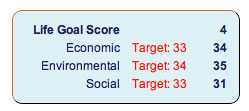
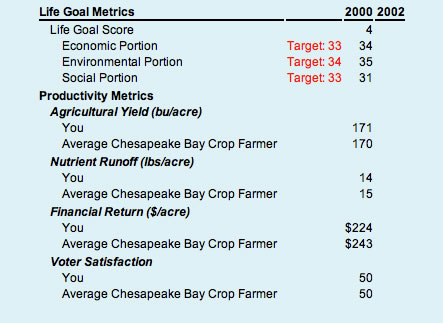
Hopefully you've scrolled through the difference types of BMPs and farming techniques on the page earlier. The choices you make each round as a farmer will be presented to you in the method shown below. Every turn, you will have the opportunity to pick how you want to farm.
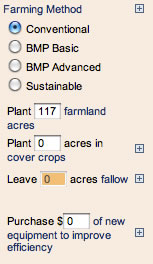
Farming Method:
Conventional farming refers to traditional, industrial grade farming that uses large amounts of chemical fertilizers and fuel. This option is financially cheapest, but most costly to the environment.
BMP Basic means that you will apply some sort of basic unspecified BMPs to your cropland that will diminish your nutrient contribution to the Bay. However, this is in conjunction with conventional farming practices.
Choosing BMP Advanced means that you are using BMPs that will diminish the nutrient runoff even more than Basic BMPs. You are still farming conventionally but at the same time utilizing practices that can at least partially mitigate your nutrient impact. Keep in mind that any BMPs you use will cost money, but you may be incentivized by the Crop Regulator to help offset these costs.
Sustainable farming describes an ecologically-friendly method of cultivation. This option is the least environmentally detrimental method, but operating expenses are more. The price per bushel for sustainably raised produce is generally higher, but the yield per acre is lower.
Land Use Choices:
The next box lets you specify how many acres you want to plant; viewing the table below helps in making this decision. Consider your operating expenses per acre, price per bushel, and incentives when deciding.
Below this, you can choose to plant cover crops in order to help secure soil against erosion, as well as reduce the amount of excess fertilizer applied to the cropland. The Crop Regulator may incentivize this practice as well, as planting cover crops is expensive to individual farmers.
Leaving land fallow can reduce your operating expenses while also decreasing your nutrient impact, as it implies fertilizer will not be spread on the fields. However, it is economically difficult unless incentives or prices are exceptionally high.

Buying more equipment boosts the amount of yield per acre you can get with the same amount of operating expense. This is a good way to get more out of less farm land, thus reducing the nutrient output.
As the game progresses, income and Bay health are compared in a line graph as shown below. Hopefully, you can manage to maintain a stable, adequate income without seeing any major dips in Bay health.

After each game advancement, a summary like the one below will appear. This allows you to reevaluate between turns and plan what farming changes to make. Things to watch out for include debt, low crop prices, and operating expenses. Also, the Crop Farmer Regulator may have changed incentives, so be sure to check the bottom portion of the "Player Information" section.

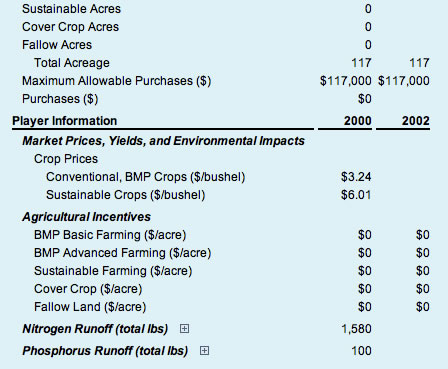
More Tips:
- It may seen like a lot of information to digest at first, but don't despair! Explore the graphs and summaries provided between turns so you can make calculated decisions; after a few turns it is easier to get in a rhythm.
- Remember to communicate! Talk to the Crop Regulator, as he or she has a large part in how your life balance score fares.
A Word on the Crop Regulator:
The Regulator sees much of the same information and summary tables as the farmer he or she is regulating. However, instead of making choices on farming techiniques, the following choices are presented:
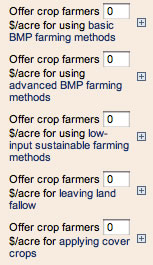
Each box is a chance to offer the Crop Farmer financial incentives to farm in more Bay-friendly ways. Be sure to pay attention to the Regulation Budget that gets posted at the top of the summary table, as shown below. You do not want to exhaust your budget! Communication with the Crop Farmer is key, as it is important to come up with an incentive plan that allows he or she to make an adequate income while benefitting the Bay.

